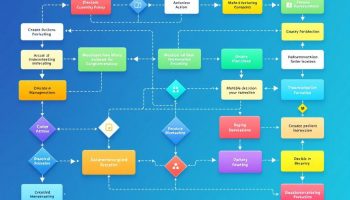
Agile Methodology in DevOps
Agile methodology in DevOps transforms software development, boosting efficiency and collaboration. Integrating agile principles with DevOps practices helps companies enhance their software delivery performance, with 80% of global organizations now using these complementary approaches.
Key Takeaways:
- DevOps teams implementing agile practices deploy 208 times more frequently and recover from incidents 2,604 times faster.
- Organizations experience up to 50% reduction in software delivery costs and 22% fewer production bugs.
- Continuous integration and automated testing form the backbone of successful agile DevOps implementation.
- Cross-functional collaboration and breaking down traditional silos are critical for effective adoption.
- High-performing teams achieve a 75.4% project success rate using agile methodology in DevOps.
The fusion of agile methodologies and DevOps creates a powerful framework for rapid, reliable software delivery. This combination addresses common development challenges by prioritizing shorter development cycles and constant feedback.
DevOps teams that embrace agile principles see dramatic improvements in deployment speed and quality. The data speaks for itself – organizations report faster time-to-market and significantly reduced costs.
Automated testing serves as a critical component in this process. By automating test procedures, you’ll catch bugs earlier in the development cycle, reducing expensive fixes later. This approach aligns perfectly with the core agile value of delivering working software frequently.
Cross-functional collaboration stands as the foundation of successful implementation. Breaking down departmental barriers allows for streamlined communication and faster problem-solving. Teams that maintain open channels between developers, operations staff, and quality assurance professionals consistently outperform those that don’t.
Continuous integration practices enable you to merge code changes reliably throughout the day. This creates a stable foundation for continuous delivery, allowing frequent updates to reach production environments quickly and safely.
For effective adoption, focus on cultural shifts alongside technical implementations. DevOps requires a mindset change that values collaboration, experimentation, and shared responsibility. Your organization will benefit most when these cultural elements align with technical practices.
The statistics confirm this approach works. High-performing teams achieve remarkable project success rates by combining these methodologies. Start with small, incremental changes rather than attempting a complete organizational overhaul.
Implementing feature flags gives you control over which features reach users, allowing for progressive feature rollouts while maintaining system stability. This technique supports the agile principle of delivering customer value early and often.
Measuring success requires appropriate metrics. Track deployment frequency, lead time, change failure rate, and mean time to recovery to gauge your progress accurately.
“Embracing Agile within DevOps revolutionizes software development, propelling organizations toward unmatched efficiency and collaboration. With high-performing teams deploying 208 times more frequently and achieving a staggering 75.4% project success rate, the integration of these methodologies is not just a trend—it’s the future of software delivery.”
The Strategic Imperative
Combining agile methodology in DevOps creates a powerful synergy that transforms software development processes. With 80% of global organizations adopting these complementary approaches, you gain a competitive edge through optimized software lifecycle management and operational efficiency. The integration focuses on key principles of collaboration, continuous delivery, and adaptability to meet evolving market demands.
When you implement agile methodologies alongside DevOps practices, you create an environment where teams can respond quickly to changing requirements while maintaining reliable delivery systems. This strategic alignment helps break down traditional silos between development and operations teams, fostering greater cross-functional collaboration.
Core Benefits of Agile in DevOps
The agile methodology in DevOps offers several tangible advantages for your software development efforts:
- Accelerated deployment frequency – High-performing DevOps teams deploy 208 times more frequently than traditional counterparts
- Dramatically improved recovery times – Incidents are resolved 2,604 times faster with proper implementation
- Enhanced quality assurance – Production bugs are reduced by 22% when using agile DevOps practices
- Significant cost reductions – Organizations experience up to 50% reduction in software delivery costs
Adopting project delivery frameworks like Scrum or Kanban within your DevOps pipeline enables you to maintain alignment with the four core Agile values while embracing the CALMS framework (Culture, Automation, Lean, Measurement, Sharing) essential for DevOps success.
The following comparison illustrates how agile methodology in DevOps transforms key performance metrics:
| Metric | Traditional Approach | Agile DevOps Approach |
|---|---|---|
| Deployment Frequency | Monthly/Quarterly | Multiple times daily |
| Change Lead Time | Weeks/Months | Hours/Days |
| Mean Time to Recovery | Days | Minutes/Hours |
| Change Failure Rate | 60% | Less than 15% |
| Project Success Rate | Below 30% | 75.4% |
As you consider implementation strategies, focus on addressing the three most common challenges: cultural resistance (54%), skills shortage (49%), and legacy system integration (45%). By tackling these issues systematically, you’ll position your organization to realize the full potential of continuous improvement through agile methodology in DevOps.
High-performing teams utilizing DevOps and Agile methodologies deliver 200 times more frequently than their peers, with 24 times faster recovery from failures.
forbes.com
Foundations of Agile and DevOps
The agile methodology in DevOps combines two powerful approaches that transform how software development teams operate. With 80% of organizations worldwide adopting these complementary practices, you’ll gain a competitive edge by understanding their synergistic relationship.
The four core values from the 2001 Agile Manifesto remain the foundation for modern development practices:
- Individuals and interactions over processes and tools
- Working software over comprehensive documentation
- Customer collaboration over contract negotiation
- Responding to change over following a plan
These principles align perfectly with continuous improvement practices in DevOps environments. The CALMS framework further supports this integration:
Understanding CALMS in DevOps
The CALMS framework provides structure to agile methodology in DevOps implementation:
- Culture: Breaking down silos between development and operations teams
- Automation: Reducing manual work to increase reliability and speed
- Lean: Eliminating waste and optimizing workflows
- Measurement: Data-driven decision making and improvement
- Sharing: Knowledge exchange and collaboration across teams
You’ll find several frameworks support this approach, including Scrum, Kanban, and Dynamic Systems Development Method. Each offers different strengths for project communication and delivery.
The business impact of agile methodology in DevOps is substantial:
- Amazon Web Services deploys code every 11.7 seconds using DevOps
- High-performing teams deploy 208 times more frequently
- Agile projects achieve a 75.4% success rate
- Automated testing increases release frequency by 25%
These metrics demonstrate why implementing agile methodology in DevOps creates operational advantages. By focusing on quality and efficiency, your organization can reduce production bugs by 22% and achieve 60% higher change success rates.
Despite clear benefits, challenges exist. Cultural resistance (54%), skills shortages (49%), and legacy system integration (45%) remain common obstacles. To overcome these, develop a strategic planning approach that addresses both technical and human factors.
As agile methodology in DevOps continues evolving, trends like AI-driven automation, DevSecOps, and cloud-native architectures will reshape implementation strategies. With the global DevOps market projected to reach $15.06 billion by 2025, organizations investing in these practices now position themselves for future success.

Accelerating Delivery and Performance
DevOps teams that embrace agile methodology in DevOps achieve remarkable performance improvements. Amazon Web Services exemplifies this synergy, deploying code every 11.7 seconds after implementing DevOps practices. This rapid deployment capability isn’t an outlier – high-performing teams deploy 208 times more frequently and recover from incidents 2,604 times faster than their traditional counterparts.
The integration of agile methodology in DevOps creates measurable business benefits. Projects following agile principles achieve a 75.4% success rate, significantly outperforming conventional approaches. When you implement automated testing as part of your DevOps pipeline, you can expect to increase release frequency by approximately 25%, allowing your teams to deliver value to customers more rapidly.
Quality and Efficiency Gains
Adopting agile methodology in DevOps doesn’t just accelerate delivery – it enhances quality. Organizations report a 22% reduction in production bugs when implementing DevOps practices properly. This improvement stems from the continuous integration and automated testing that forms the backbone of effective project collaboration.
The financial impact is equally compelling. You’ll experience approximately 50% reduction in software delivery costs through agile methodology in DevOps implementation. Additionally, 61% of organizations report enhanced deliverable quality, and teams achieve a 60% higher change success rate when following these practices.
To maximize these performance benefits, consider these implementation strategies:
- Build cross-functional teams that break down traditional silos
- Establish continuous integration/continuous deployment pipelines
- Implement automated testing at all levels (unit, integration, system)
- Create feedback loops that inform rapid iterations
- Deploy small, frequent updates rather than large, risky releases
These challenges require thoughtful project leadership to overcome common obstacles like cultural resistance (affecting 54% of organizations), skills shortages (49%), and legacy system integration (45%). However, the potential rewards include 50% improved customer satisfaction, 46% higher employee productivity, and 43% faster time to market.
The agile methodology in DevOps approach transforms how your organization delivers software by emphasizing collaboration, automation, and continuous improvement. When implemented effectively, it creates a competitive advantage through faster delivery, higher quality, and more responsive development cycles.

Quality and Operational Efficiency
Implementing agile methodology in DevOps significantly enhances quality and operational efficiency across software development lifecycles. DevOps practices demonstrably reduce production bugs by 22%, allowing your teams to deliver more reliable software with fewer defects. This improvement stems from the continuous integration and automated testing that form the backbone of agile methodology in DevOps environments.
Organizations report remarkable improvements after adopting this combined approach. About 61% of companies experience enhanced deliverable quality when implementing agile methodology in DevOps, while achieving a 60% higher change success rate for deployments. The financial impact is equally impressive, with a 50% reduction in software delivery costs being a common outcome.
Key Quality Improvements Through Agile DevOps Integration
The integration of agile methodology in DevOps creates several measurable quality benefits:
- Reduced defect rates through continuous testing and early bug detection
- Improved code quality through pair programming and code reviews
- Enhanced system reliability through infrastructure as code
- Higher customer satisfaction through faster feature delivery
- Better alignment between business requirements and technical implementation
Continuous integration serves as a cornerstone for quality enhancement. By leveraging agile methodology tools that support automated builds and tests, your teams can identify issues early in the development cycle before they become costly problems. This approach aligns perfectly with the continuous improvement philosophy central to both agile and DevOps.
The operational efficiency gains are particularly notable in complex environments. By implementing automated deployment pipelines, your teams can reduce manual errors and accelerate delivery cycles. Organizations that successfully implement agile methodology in DevOps typically experience shorter lead times between ideation and production deployment.
This efficiency manifests in tangible business outcomes. Your teams can respond more quickly to market changes and customer feedback while maintaining high quality standards. The data shows that implementing these practices leads to faster recovery from incidents and more stable production environments.
For optimal results, you should focus on implementing consistent quality gates throughout your delivery pipeline. These automated checkpoints ensure that code meets defined quality criteria before progressing to the next stage of deployment. When properly implemented, this approach enables your teams to maintain quality while increasing delivery velocity.
Organizations that adopt agile methodology in DevOps report a 60% higher success rate in deployments, significantly enhancing operational efficiency and quality.
cio.com
Market Adoption and Future Trends
The global DevOps market is projected to reach $15.06 billion by 2025, with agile methodology in DevOps driving this explosive growth. Between 74-81% of organizations have already incorporated DevOps practices into their development workflows, recognizing the competitive advantage they provide in today’s fast-paced digital landscape.
Organizations implementing agile methodology in DevOps are experiencing remarkable benefits across their software development lifecycle. These advantages include a 50% improvement in customer satisfaction, 46% higher employee productivity, and 43% faster time to market. These metrics demonstrate why project delivery frameworks that integrate agile practices have become essential for modern businesses.
Several emerging trends are shaping the future of agile methodology in DevOps:
- AI-driven automation (AIOps) is revolutionizing how teams handle operations by providing predictive analytics and automating routine tasks.
- DevSecOps practices are embedding security throughout the development lifecycle rather than treating it as an afterthought.
- Platform engineering is creating self-service infrastructure to empower development teams.
- Cloud-native architectures are enabling greater flexibility and scalability.
Despite the clear benefits, organizations face significant challenges when implementing agile methodology in DevOps. Cultural resistance remains the biggest hurdle at 54%, followed by skills shortages (49%) and legacy system integration difficulties (45%). Successful continuous improvement requires addressing these barriers through proper training and organizational alignment.
Adoption Strategies for Maximum Impact
To maximize the benefits of agile methodology in DevOps, consider these proven implementation approaches:
- Start with small, cross-functional teams focused on specific business objectives.
- Invest in automation tools that support continuous integration and deployment.
- Establish clear metrics to measure progress and demonstrate value.
- Develop a learning culture where experimentation is encouraged.
- Integrate security practices from the beginning.
The combination of agile methodology in DevOps represents a fundamental shift in how software is conceived, built, and delivered. By embracing these complementary approaches, your organization can achieve the agility needed to thrive in rapidly changing markets while maintaining the reliability required for mission-critical applications.
Companies that successfully implement distributed agile models report significant improvements in their ability to respond to changing business requirements while maintaining operational stability.
Implementing Agile and DevOps: Practical Strategies
Integrating agile methodology in DevOps requires thoughtful planning and execution to maximize your team’s potential. When implemented correctly, these complementary approaches can transform your software development lifecycle, with 80% of global organizations now adopting these practices to remain competitive in the digital marketplace.
You’ll need to overcome common implementation challenges before realizing the full benefits. Cultural resistance (54%), skills shortage (49%), and legacy system integration (45%) typically stand as the most significant hurdles. However, the rewards justify the effort: 50% improved customer satisfaction, 46% higher employee productivity, and 43% faster time to market.
Implementation Framework for Success
Start by establishing cross-functional teams that break down traditional silos between development and operations. This foundational step supports the collaboration essential to agile methodology in DevOps. When Amazon Web Services implemented this approach, they achieved code deployment every 11.7 seconds – a remarkable improvement in delivery speed.
You should incorporate these proven strategies:
- Adopt automated CI/CD pipelines to enable continuous integration and delivery
- Implement infrastructure as code (IaC) to standardize environment creation
- Establish comprehensive monitoring and feedback mechanisms
- Practice test-driven development with automated testing frameworks
- Conduct regular retrospectives to identify improvement opportunities
The results speak for themselves. High-performing DevOps teams deploy 208 times more frequently and recover from incidents 2,604 times faster than traditional teams. Additionally, effective project collaboration using agile methodology achieves a 75.4% success rate compared to traditional approaches.
Your measurement strategy should track key performance indicators:
| Performance Metric | Average Improvement |
|---|---|
| Deployment Frequency | 208x higher |
| Lead Time for Changes | 106x faster |
| Mean Time to Recovery | 2,604x faster |
| Change Failure Rate | 7x lower |
Organizations implementing agile methodology in DevOps report significant quality improvements, with DevOps practices reducing production bugs by 22% and 61% of organizations reporting enhanced deliverable quality. This quality improvement stems from the continuous improvement ethos embedded in both approaches.
For optimal results, integrate DevSecOps principles, incorporating security throughout your development lifecycle rather than treating it as a separate phase. This approach aligns with emerging trends like AI-driven automation (AIOps) and cloud-native architectures that will shape the future of the global DevOps market, projected to reach $15.06 billion by 2025.






